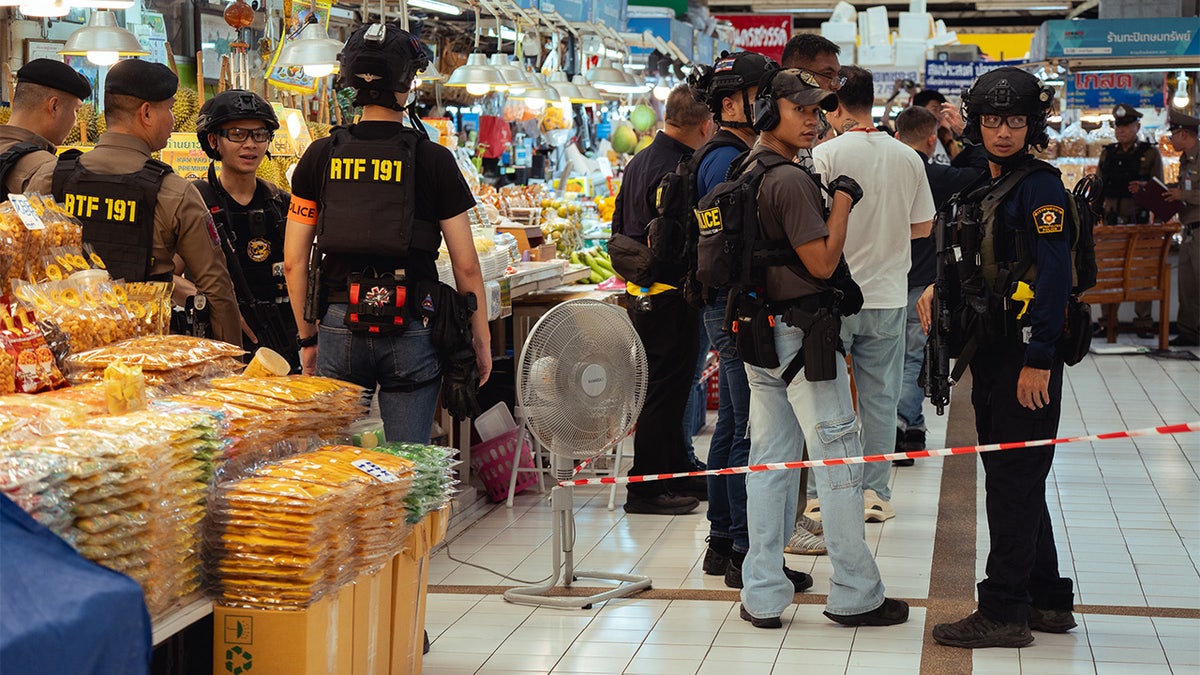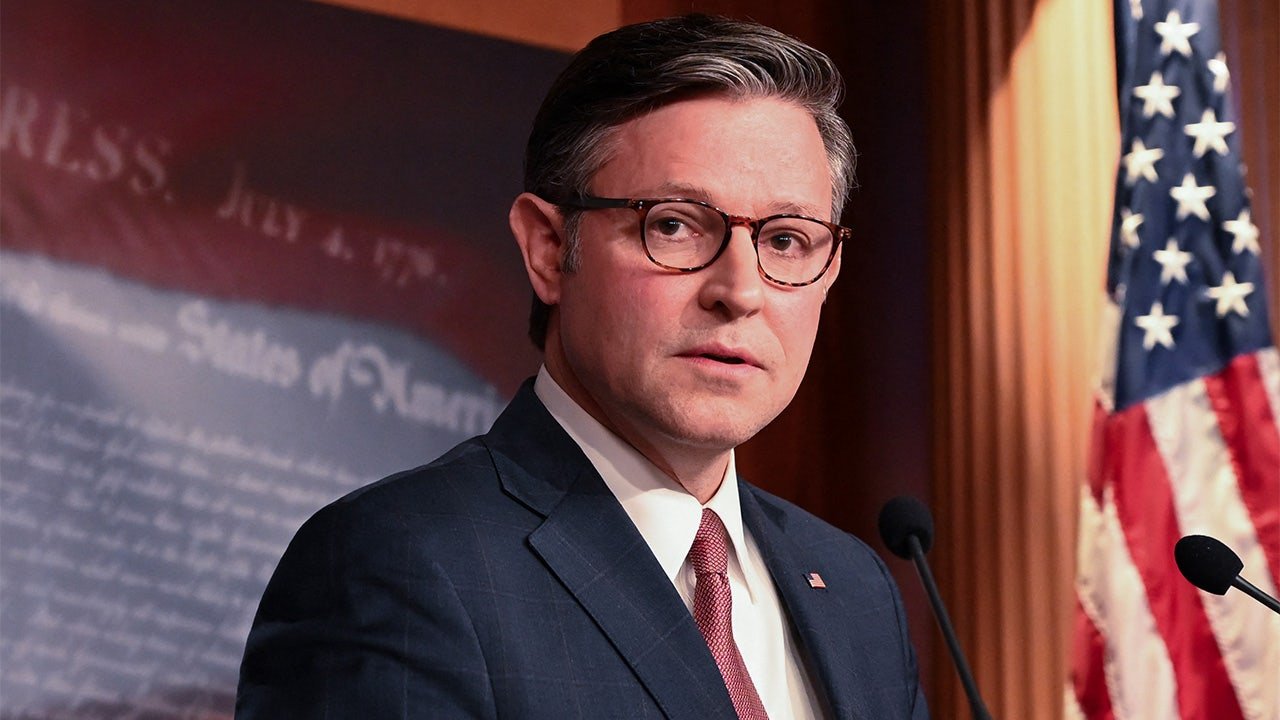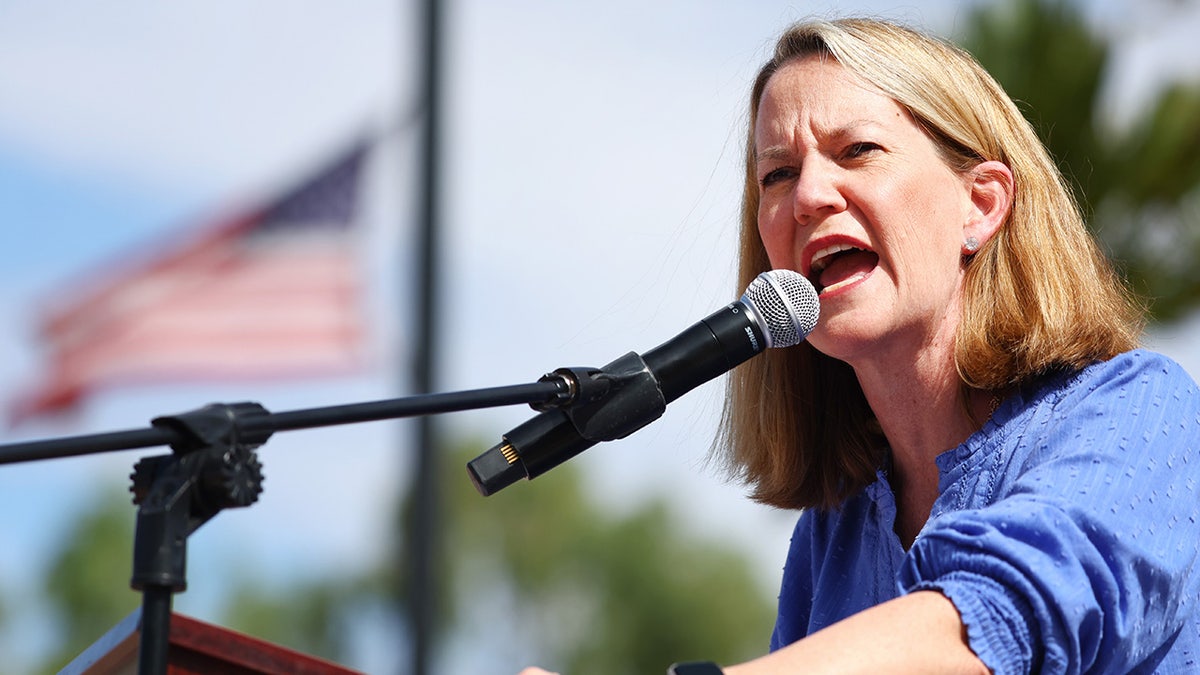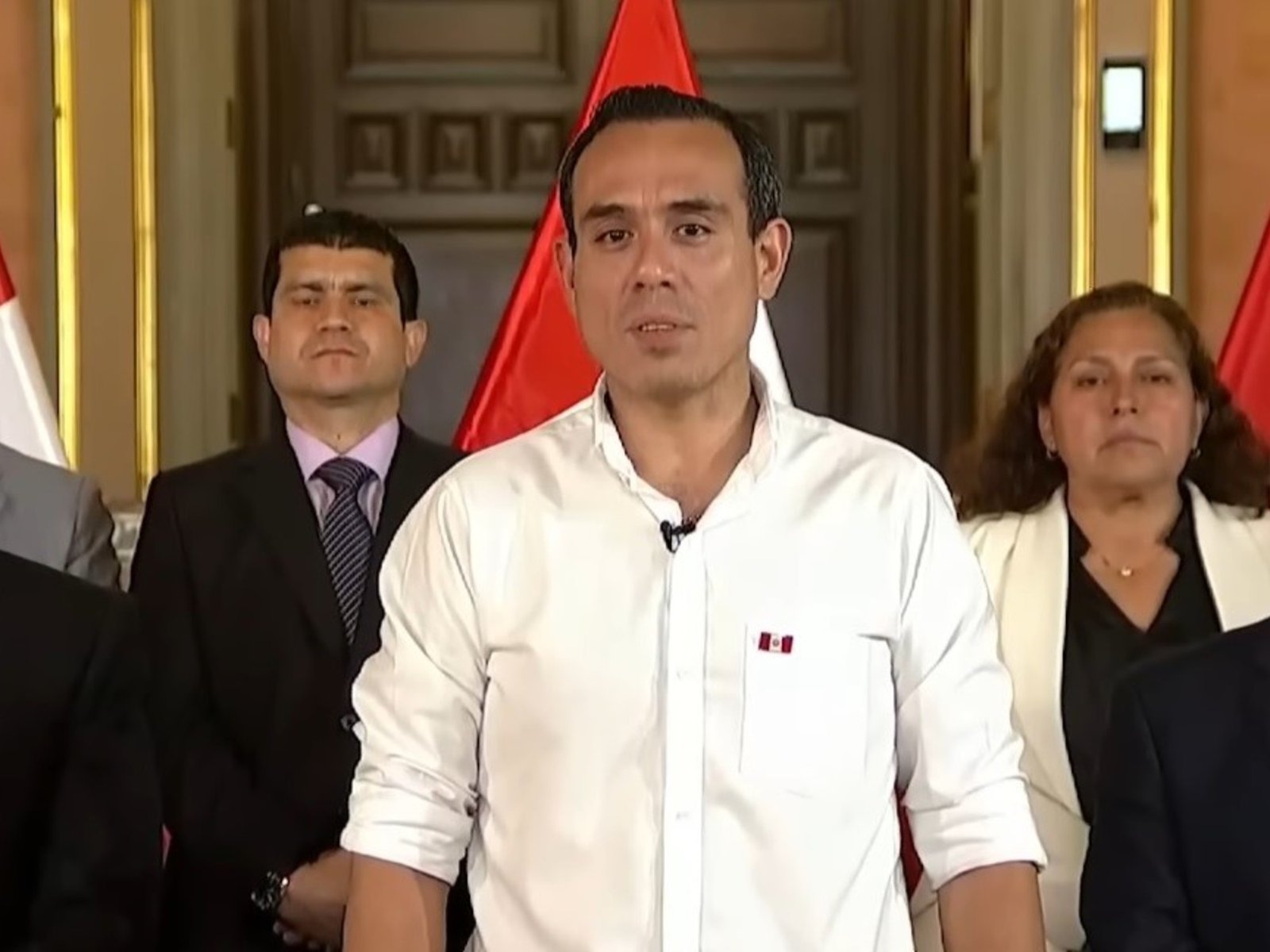INTERNACIONAL
Multiple people killed in mass shooting incident at Bangkok market: police

NEWYou can now listen to Fox News articles!
Multiple people were shot and killed at a market in the Thai capital of Bangkok on Monday afternoon, police said.
A post on the official Facebook page of the Royal Thai Police says there were at least six fatalities, including the gunman who took his own life.
TRUMP CALLS FOR IMMEDIATE CEASEFIRE BETWEEN CAMBODIA AND THAILAND AMID ESCALATING VIOLENCE
Police monitoring the cordoned area in Or Tor Kor market on July 28, 2025 in Bangkok, Thailand. (Mailee Osten-Tan/Getty Images)
Photos show police on scene at the Or Tor Kor market in Bangkok, which sells agricultural produce and local food.
The victims included four security guards and one woman, according to the Erawan Emergency Medical Center that monitors Bangkok hospitals.
THAILAND, CAMBODIA TROOPS OPEN FIRE ON EACH OTHER, KILLING AT LEAST 12
Monday’s violence came against the backdrop of five days of violent border clashes between Thailand and its neighbor, Cambodia.

Police tape around a store inside Or Tor Kor wet market on July 28, 2025 in Bangkok, Thailand. (Mailee Osten-Tan/Getty Images)
Leaders on either side were meeting in Malaysia on Monday in an urgent effort to resolve the fighting.

Police monitoring the cordoned area in Or Tor Kor market on July 28, 2025 in Bangkok, Thailand. (Mailee Osten-Tan/Getty Images)
U.S. Secretary of State Marco Rubio said State Department officials were on the ground in Malaysia to assist in the peace talks.
CLICK HERE TO GET THE FOX NEWS APP
«Both President Trump and I remain engaged with our respective counterparts for each country and are monitoring the situation very closely,» Rubio said in a statement. «We want this conflict to end as soon as possible.»
This is a developing story. Check back for updates.
Reuters contributed to this report.
INTERNACIONAL
Cómo el estrés acelera el envejecimiento biológico: claves y consejos para revertirlo, según la ciencia

El estrés puede acelerar el proceso de envejecimiento biológico en personas de todas las edades. Esto ocurre cuando el organismo enfrenta situaciones que exceden sus recursos, lo que produce una sobrecarga que afecta tanto la salud física como la mental.
Distintos estudios científicos señalan que las marcas del estrés intenso en el cuerpo son visibles, pero reversibles si la causa desaparece. La relación entre el estrés y el envejecimiento despierta un interés especial en la actualidad, donde la expectativa de vida supera los 60 años en gran parte del mundo.
En ese sentido, expertos consultados por Psicología y Mente aseguraron que es esencial comprender la diferencia entre la edad cronológica y la edad biológica. La primera define el tiempo transcurrido desde el nacimiento de una persona.

En cambio, la edad biológica se refiere al estado real del organismo en comparación con ese tiempo. Este concepto incorpora la genética y los hábitos de vida. Un factor relevante es el estrés, que podría provocar que la edad biológica aumente y se distancie de la cronológica, acelerando así el envejecimiento.
De acuerdo con la información presentada por los especialistas, el estrés es una reacción natural frente a demandas que superan la capacidad de respuesta del individuo. El cuerpo y la mente activan este proceso para afrontar situaciones adversas.
Esta activación permite superar obstáculos, mejora la eficiencia y favorece la adaptación en ciertas circunstancias. Sin embargo, si la recuperación no se produce y el estrés persiste, el organismo sufre un desgaste significativo que afecta las funciones físicas y mentales.

Los síntomas del estrés afectan varios ámbitos de la salud. Entre los más habituales se encuentran dolores de cabeza, trastornos digestivos, rigidez en la mandíbula, fatiga y cansancio. Además, investigaciones recientes demuestran que el impacto no se limita a molestias puntuales, sino que también propicia un envejecimiento acelerado a nivel biológico.
Ciertos momentos de la vida, como una cirugía, una internación en la unidad de cuidados intensivos por una enfermedad como el COVID-19, o el embarazo, pueden generar un aumento medible en la edad biológica. Un trabajo publicado en la revista Cell Metabolism documentó que el incremento en la edad biológica, producido en estos escenarios, puede revertirse días o meses después cuando desaparece la causa del estrés.
En tanto, un estudio previo, también publicado en Cell Metabolism, demostró que incluso una sola noche de privación de sueño genera aumentos medibles en la edad biológica a través de marcadores epigenéticos e inmunológicos. Sin embargo, los investigadores comprobaron que estos efectos pueden revertirse completamente cuando se restablecen patrones normales de descanso.

En ese tono, la investigación dirigida por Jesse R. Poganik y su equipo, perteneciente al Departamento de Medicina del Brigham and Women’s Hospital, Facultad de Medicina de Harvard, examinó muestras de sangre en pacientes mayores que se sometieron a una intervención quirúrgica.
Según los datos obtenidos, la edad biológica mostró una notable elevación inmediatamente antes del procedimiento. Sin embargo, los valores regresaron a lo habitual entre cuatro y siete días después de la operación. El estudio también incluyó a personas hospitalizadas por COVID-19 y a mujeres gestantes. En ambos grupos, una vez finalizada la situación estresante, la edad biológica volvió a registros similares a los anteriores.
El patrón se observa con claridad: mientras el factor estresante está presente, la edad biológica aumenta. Cuando se elimina ese factor, el cuerpo puede recuperar su estado anterior. Este hallazgo genera optimismo, ya que indica que los efectos negativos del estrés sobre el envejecimiento no resultan definitivos en la mayoría de los casos.

De acuerdo con información recopilada en Psicología y Mente, la resiliencia psicológica cumple un rol fundamental en la protección frente a los daños del estrés. Las personas con mayor capacidad de adaptación a las dificultades experimentan menos aceleración en el envejecimiento biológico. Investigadores observaron que quienes regulan mejor sus emociones y mantienen autocontrol logran mayor resistencia a los efectos del estrés en el organismo.
La adopción de hábitos saludables también contribuye a reducir el impacto negativo del estrés sobre el proceso de envejecimiento. Según los especialistas citados por Psicología y Mente, una alimentación equilibrada, la actividad física regular, la abstinencia de tabaco y alcohol, y el cuidado emocional favorecen la prevención de enfermedades y fortalecen la capacidad de recuperación. Estas pautas ayudan a mantener durante más tiempo la autonomía y la calidad de vida.
La ciencia considera el envejecimiento como una acumulación de daños celulares y moleculares, un proceso que se acelera cuando el cuerpo se ve sometido de manera sostenida a situaciones que generan estrés. Este desgaste puede reducir la funcionalidad física y mental, aumentar el riesgo de enfermedades e, incluso, adelantar la aparición de dependencia.

Los resultados de las investigaciones recientes revelan la importancia de prestar atención a los signos de estrés y de buscar recuperarse en forma activa. Cuando las personas logran calmar los factores que les provocan sobrecarga, los indicadores biológicos mejoran y la “edad” del organismo desciende hasta alcanzar registros normales.
El conocimiento sobre la relación entre estrés y envejecimiento permite a individuos y comunidades actuar de manera informada. La salud integral requiere atención tanto en el plano físico como en el mental. La detección y la gestión efectiva del estrés, sumadas a la resiliencia y a estilos de vida saludables, constituyen las mejores estrategias para cuidar el cuerpo y mantener el bienestar a lo largo de los años.
El control del estrés, la adopción de hábitos sanos y el fortalecimiento emocional se imponen así como claves en la búsqueda de una vida larga y plena. La evidencia muestra que evitar el impacto negativo del estrés está al alcance de la mayoría si se asumen conductas de cuidado y prevención.
adult,anxiety,burnout,business,business operations,business pressure,business tasks,businesswoman,camera,challenges,company,computer,corporate,deadline,deadlines,disappointment,emotional strain,employee,enterprise,entrepreneur,executive,exhaustion,fatigue,financial,frustration,goals,growth,headache,laptop,low energy,manager,managing,mental,mental exhaustion,migraine,multinational company,objectives,office,office burnout,overload,overwhelmed,pressure,professional,professional struggle,project,projects,stress,successful,technology,tough day,woman,worker
INTERNACIONAL
Speaker Johnson hit with Democrat-led lawsuit over delayed swearing-in amid House shutdown chaos

NEWYou can now listen to Fox News articles!
The state of Arizona is suing Speaker Mike Johnson, R-La., over the delayed swearing-in of Rep.-elect Adelita Grijalva, D-Ariz.
«Speaker Mike Johnson is actively stripping the people of Arizona of one of their seats in Congress and disenfranchising the voters of Arizona’s seventh Congressional district in the process,» Arizona Attorney General Kris Mayes, a Democrat, said in a statement.
«By blocking Adelita Grijalva from taking her rightful oath of office, he is subjecting Arizona’s seventh Congressional district to taxation without representation. I will not allow Arizonans to be silenced or treated as second-class citizens in their own democracy.»
Johnson dismissed the lawsuit as a bid to get «national publicity» in comments to reporters earlier this week and on Tuesday evening.
BATTLEGROUND REPUBLICANS HOLD THE LINE AS JOHNSON PRESSURES DEMS ON SHUTDOWN
Speaker of the House Mike Johnson speaks during a news conference at the U.S. Capitol on the tenth day of the federal government shutdown on Oct. 10, 2025, in Washington, D.C. (Alex Wroblewski/AFP via Getty Images)
«I think it’s patently absurd. We run the House. She has no jurisdiction. We’re following the precedent,» Johnson said in response to the state attorney general. «She’s looking for national publicity, apparently she’s gotten some of it, but good luck with that.»
Grijalva won a special election on Sept. 23 to replace her father, late Rep. Raul Grijalva, D-Ariz., after he passed away from cancer at age 77.
Johnson has repeatedly said that Grijalva will be sworn into office when the House returns to its regular sessions. But it’s not clear when exactly that will be — the House GOP leader has threatened to keep his lawmakers out of Washington, D.C., until the ongoing government shutdown is over.
It’s a bid to pressure Senate Democrats, led by Minority Leader Chuck Schumer, D-N.Y., to agree to the GOP’s plan to fund the federal government through Nov. 21.
But Schumer and his allies have resisted thus far, sinking the Republican-led bill 11 times and keeping the shutdown going for 21 days.
House Democrats have accused Johnson of playing politics and depriving Arizona’s 7th Congressional District of representation in the process.
«Republicans on vacation for four weeks — and one of the consequences of that is that Republicans have refused, now for four consecutive weeks, to swear in Representative-elect Adelita Grijalva, depriving hundreds of thousands of people in the state of Arizona of the representation that they deserve, particularly during this challenging moment in the country,» House Minority Leader Hakeem Jeffries, D-N.Y., said during a press conference on Tuesday.

Rep.-elect Adelita Grijalva is interviewed in Tucson, Arizona, on July 15, 2025 (Rebecca Noble/Getty Images)
Johnson, in response to Democrats’ criticism, has repeatedly pointed out that the House was not in session when Grijalva won her election.
He’s also argued that he was following precedent set by former Speaker Nancy Pelosi, D-Calif., who waited 25 days to swear in Rep. Julia Letlow, R-La., in 2021.
Letlow had won a special election to replace her husband, Rep.-elect Luke Letlow, R-La., who died during the COVID-19 pandemic before he could be sworn into office in January 2021.
«We are not in legislative session. The chronology is important. Rep. Grijalva won her race, I think it was the last week of September, after we had already gone out of session. So I will administer the oath to her, I hope, on the first day we come back,» Johnson said.
58 HOUSE DEMS VOTE AGAINST RESOLUTION HONORING ‘LIFE AND LEGACY’ OF CHARLIE KIRK
«I’m willing and anxious to do that. In the meantime, instead of doing TikTok videos, she should be serving her constituents.»
Grijalva has argued she cannot perform her legislative or constituent duties without being sworn in first, which Johnson and Republicans have disputed.
But her swearing-in is also key to the ongoing battle over Jeffrey Epstein documents going on in the House.
Once made a member of Congress, Grijalva is expected to be the deciding signature on a measure aimed at forcing a House-wide vote on releasing Epstein documents in the Department of Justice’s (DOJ) possession.

Arizona Attorney General Kris Mayes, then a Democratic candidate for her role, speaks at a Women’s March rally outside the State Capitol on Oct. 8, 2022 in Phoenix, Arizona. (Mario Tama/Getty Images)
CLICK HERE TO GET THE FOX NEWS APP
The measure, called a discharge petition, is designed to end-run House leaders on specific legislation — provided it has a majority of lawmakers’ signatures.
Johnson and House GOP leaders have called the measure superfluous and political, pointing to the chamber’s own ongoing investigation and procedures aimed at widening transparency into Epstein’s case.
However, the speaker has signaled he would not block the measure if it came to the House floor when Grijalva was sworn in.
Fox News Digital reached out to Johnson for a response but did not immediately hear back.
house of representatives politics,democrats,politics,mike johnson,arizona
INTERNACIONAL
Estado de emergencia en Perú: cuáles son las fuertes restricciones que paralizarán Lima y Callao por un mes

Lima quedará paralizada por un mes luego de que el presidente de Perú, José Jerí, decretara el estado de emergencia para enfrentar la ola de violencia, lo que implicó la suspensión temporal de algunos derechos constitucionales a partir de este miércoles. La medida también alcanza a la ciudad portuaria de Callao y afectará a más de 10 millones de personas.
Según el decreto publicado en el diario oficial El Peruano, mientras dure la medida quedan suspendidos derechos fundamentales como la inviolabilidad del domicilio y la libertad de reunión, en un contexto de múltiples protestas contra el Gobierno y el Congreso por diversos motivos, entre ellos la inseguridad.
Las nuevas normas permiten que las fuerzas de seguridad ingresen a cualquier vivienda y detengan a sospechosos dentro o fuera del domicilio sin orden judicial, y prohíben que la población se reúna para manifestaciones sin autorización de las autoridades.
También contempla que las Fuerzas Armadas apoyen a la Policía Nacional en el combate al crimen organizado mediante patrullas en zonas críticas, como paraderos, estaciones de metro e instituciones asociadas, y en otras situaciones de violencia.
Policías y militares custodiarán dependencias públicas e instalarán comandos temporales en coordinación con los municipios más afectados, con operativos de decomiso de armas, municiones, explosivos ilegales y artefactos pirotécnicos.
El estado de emergencia establece además restricciones en las cárceles, limitando las visitas a los internos, aplicando apagones en las celdas que permiten únicamente la iluminación y eliminando las antenas telefónicas ilegales en los alrededores.
En cuanto al tránsito, se prohíbe que dos adultos viajen en la misma moto, y las autoridades podrán solicitar documentos de identidad en las calles e incluso ingresar por la fuerza a viviendas.
El Comité de Fiscalización llevará a cabo operativos de control con apoyo de las fuerzas combinadas en áreas donde se identifiquen casos de trata de personas, venta ilegal de drogas y armas.
Las mismas medidas se aplicarán a la venta informal de chips telefónicos y equipos celulares de dudosa procedencia, suspendiendo de inmediato las líneas vinculadas a extorsiones o secuestros, según la ley vigente.
En un mensaje televisado de apenas un minuto a las 20:30 (hora local), Jerí afirmó: «La delincuencia ha crecido de manera desmesurada en los últimos años, causando un enorme dolor en miles de familias y afectando el progreso del país. Pero esto ¡se acabó!«.
Agregó que «el estado de emergencia aprobado por el Consejo de Ministros entra en vigencia a las 00 horas y por 30 días en Lima Metropolitana y el Callao», y subrayó que el gobierno pasa «de la defensiva a la ofensiva en la lucha contra el crimen, recuperando la paz, la tranquilidad y la confianza de millones de peruanos».
«Las guerras se ganan con acciones, no con palabras. ¡Viva Perú!», concluyó.
La medida es la primera acción de envergadura que toma Jerí en casi dos semanas al frente del país, donde la inseguridad es una de las principales preocupaciones de la población.
El Presidente no aclaró si pedirá al Parlamento derogar seis leyes aprobadas mientras fue legislador, consideradas por expertos como obstáculos para combatir el crimen, ya que eliminan la detención preliminar sin flagrancia, dificultan procesar partidos políticos como grupos criminales, elevan requisitos para confiscar bienes y entorpecen allanamientos y cooperación eficaz.
Jerí asumió la presidencia el 10 de octubre tras la destitución de Dina Boluarte por el Congreso, luego de un desplome en su aprobación.
Durante una multitudinaria protesta la semana pasada, que dejó un muerto en enfrentamientos con la policía, los manifestantes exigieron la renuncia del mandatario, la disolución del Parlamento y la derogación del paquete de leyes que, según expertos, debilitó la lucha contra la delincuencia.
Video
Incidentes durante una protesta frente al Congreso en Perú
Perú registra un marcado aumento de los delitos en los últimos años, con la mayoría de víctimas de la clase trabajadora: los homicidios pasaron de 676 en 2017 a 2.082 en 2024, mientras que las denuncias por extorsión subieron de 2.305 en 2020 a 21.746 el año pasado, según datos de la fiscalía.
El gobierno de Boluarte había declarado un estado de excepción en marzo, que se extendió hasta mayo, medida criticada por su escasa eficacia frente a los grupos criminales.

 CHIMENTOS2 días ago
CHIMENTOS2 días agoLa cruda confesión del Turco Naim a 1 año de la separación de Emilia Attias: «Me di cuenta que hay que aprender a estar solo»

 POLITICA3 días ago
POLITICA3 días agoExigen que Cristina Kirchner y los candidatos de Fuerza Patria aclaren si fueron financiados por el narco venezolano

 CHIMENTOS2 días ago
CHIMENTOS2 días agoPampita recibió un video inesperado de su hija Blanca en el Día de la Madre y no pudo contener la emoción















